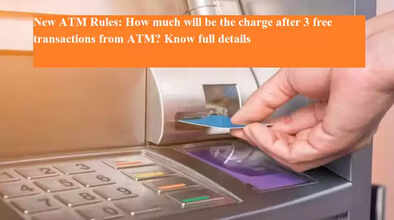New ATM Rules: How much will be the charge after 3 free transactions from ATM? Know full details

New ATM Rules: Free Transactions Limited to 3 in Metro Cities, Know Charges Beyond the Limit
Automated Teller Machines (ATMs) have made banking convenient, but now stricter rules and charges are being applied to their usage. The Reserve Bank of India (RBI) has issued updated guidelines that define how many free ATM transactions a customer can perform and what fees will apply beyond the set limit.
According to these rules, customers in metro cities are entitled to only three free transactions per month, while those in non-metro cities get five free transactions. These free transactions include cash withdrawals, balance inquiries, and non-financial activities. Once the limit is crossed, users will have to pay extra charges. Additionally, large-value cash deposits and withdrawals will now require mandatory PAN and Aadhaar verification.
Free ATM Transaction Limits
RBI has categorized cities into two groups to set transaction limits:
-
Metro Cities – Customers get 3 free transactions per month.
-
Non-Metro Cities – Customers get 5 free transactions per month.
The free limit applies to all types of ATM activities, including:
-
Cash Withdrawals
-
Balance Inquiries
-
Mini Statements or Non-Financial Transactions
This means even if you are not withdrawing cash but simply checking your balance, it will be counted as part of your free transactions.
Charges After Free Limit
Once the free limit is exhausted, customers will need to pay additional charges per transaction:
-
Cash Withdrawal: Up to ₹23 per transaction (including GST)
-
Balance Inquiry or Non-Financial Transactions: Up to ₹11 per transaction
It is important to note that these charges may vary slightly from one bank to another, as each institution has the flexibility to decide its final fee structure within RBI’s prescribed limits.
High-Value Cash Transactions
Apart from ATM usage, RBI has also introduced stricter reporting rules for high-value cash transactions.
-
If you deposit or withdraw ₹20 lakh or more in a financial year, the bank is required to report the transaction to the authorities.
-
For such high-value deposits or withdrawals, PAN and Aadhaar details are mandatory.
This move is aimed at improving transparency, preventing tax evasion, and keeping track of large cash movements.
How to Avoid ATM Charges
Frequent ATM usage can easily exhaust the free quota, leading to extra charges. Here are some practical tips to save money:
-
Use Your Own Bank’s ATM: Transactions at your home bank’s ATM are usually more cost-effective compared to other banks’ ATMs.
-
Check Balance Online: Instead of using an ATM for balance inquiries, use net banking, mobile banking apps, or SMS alerts.
-
Plan Your Withdrawals: Try to withdraw a larger amount at once instead of making multiple small withdrawals.
-
Track Your Usage: Keep a record of your ATM transactions each month so you don’t unknowingly exceed the free limit.
Why These Rules Matter
The RBI’s guidelines aim to strike a balance between customer convenience and banking system efficiency. ATMs continue to be a lifeline for cash withdrawals, especially in smaller towns and cities, but excessive usage creates costs for banks. By regulating free transactions, RBI ensures that customers use ATMs more thoughtfully while also encouraging a shift toward digital banking methods.
Key Takeaway
-
Metro Cities: 3 free ATM transactions per month
-
Non-Metro Cities: 5 free ATM transactions per month
-
Charges Beyond Limit: ₹23 per cash withdrawal, ₹11 per balance inquiry
-
High-Value Rule: Transactions above ₹20 lakh per year need PAN & Aadhaar
In short, while ATMs remain a vital part of banking, being mindful of the free limit and shifting to digital alternatives can help you avoid unnecessary charges.

